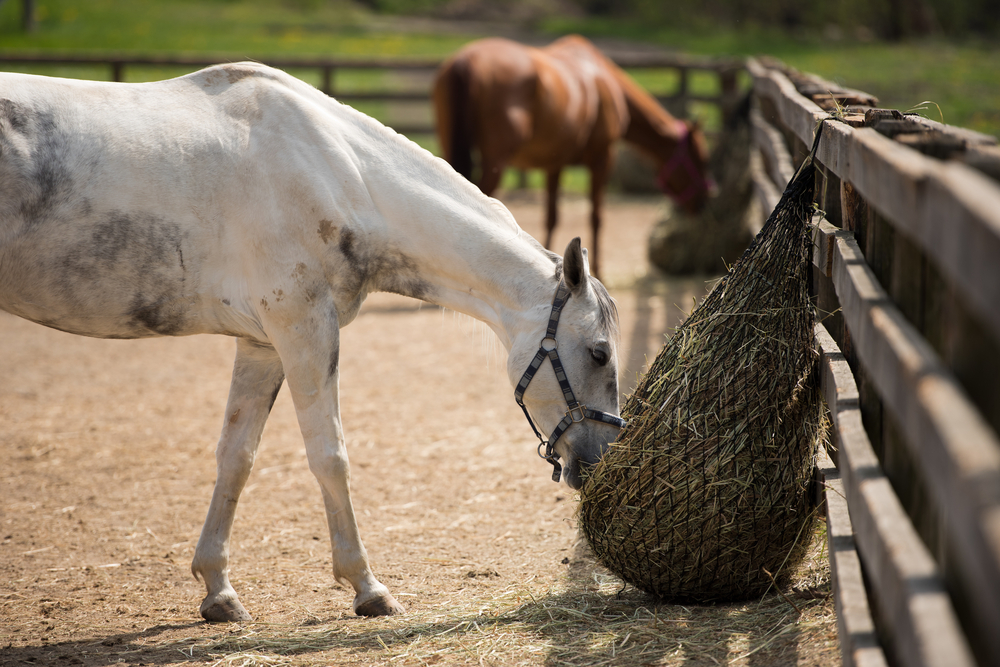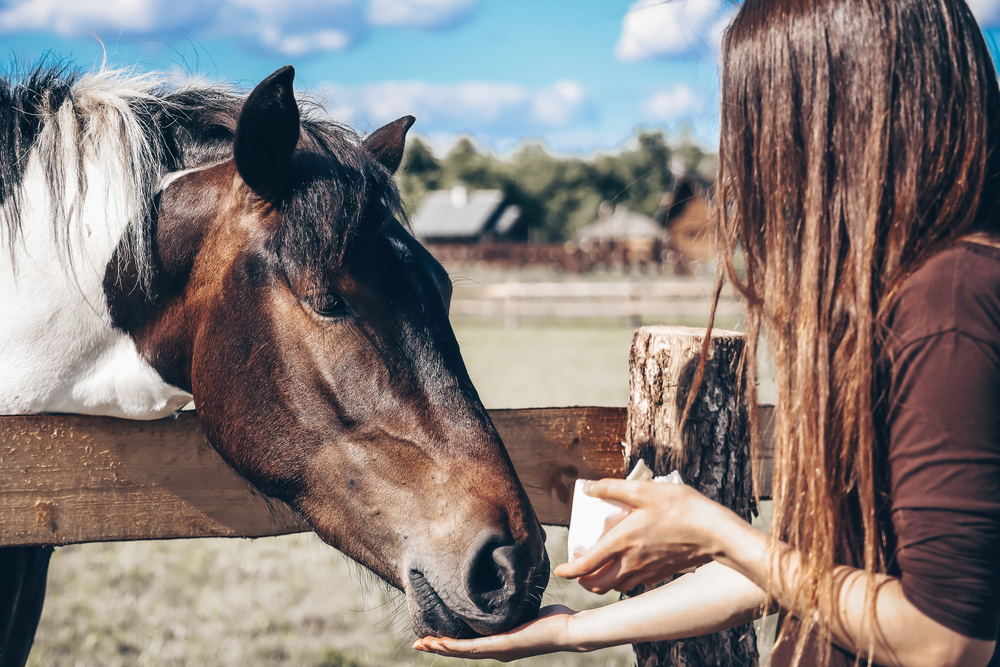- Your source for stall mats, rubber arena footing, arena harrows and arena dust control.

Do you have a horse that is difficult to deworm? Did you ever wonder if you can give the worming paste in his feed ?
?
You should not mix paste dewormer into your horse’s feed due to the risk that your horse might not get the full dose. The wormer can get stuck on the side of the feeder, and your horse might not eat all of the feed that has the dewormer on it. Improper dosing of dewormers is a considerable risk factor and can lead to resistance developing in the parasites.
Resistance issues are a big problem with two of the four deworming drugs on the market. There already a high incidence of strongyles being resistant to them.
Administering paste dewormers to horses without getting yourself and the stall splattered with worming paste takes a little planning. This article is a step-by-step guide for minimizing the mess and ensuring that your horse gets a full dose of wormer.
Why it is not recommended to mix dewormer in horse feed
Correct dosing is crucial when it comes to deworming your horse. Incorrect dosing can lead to parasites becoming resistant to the medication. Mixing the paste wormer into your horse’s feed cannot guarantee that the right amount of wormer gets into your horse.
When mixing the dewormer into your horse’s feed, your horse might not eat all of his feed leading to some of the medication going to waste. Some of the wormer can get stuck to the sides of his feeding bowl, leading to your horse not getting the total dose he needs.
How to effectively deworm your horse
Deworming is a straightforward procedure that should only take a minute to complete, but some horses can make it very difficult. It is not clear why some horses hate deworming, and some horses don’t mind. Here is a complete guide on how to administer the wormer paste to your horse.
Using the paste dewormer syringe
Paste dewormers are purchased in measured plastic syringes. The plunger of the syringe is marked in increments of 250-300 lbs. The plunger also has a plastic ring on it. This ring is used to dial to set the proper worming dose according to your horse’s weight which you will be administering to your horse.
How to measure your horse’s weight
Before you start deworming your horse, you need to know how much your horse weighs. Using an “equine height and weight measure tape,” you can quickly figure out your horse’s weight. These horse measuring tapes are inexpensive and can easily be found at your local feed stores and tack shops.
Your horse should be standing on a level surface; take the measuring tape and wrap it around your horse’s girth area just behind his withers. Pull the measure tape snug but not tight and read the measurement. You should do it 2 or 3 times and take the average measurement.
Find the correct dose on the syringe
When you know how much your horse weighs, you can set the dial on the paste wormer syringe to the correct dosage according to your horse’s weight. Twist the ring on the plunger on the syringe to unlock it. Guide it over to the right weight for your horse marked on the plunger. Twist it down to lock it in the spot and remove the small plastic cap on the tip of the syringe.
Administering the paste wormer to your horse
Generally, deworming horses with paste wormer is easy, but sometimes horses are not cooperative, making it challenging. Some horse owners prefer to tie up their horses, and others prefer to have their horses stand free. It is up to you.
At a minimum, you should halter your horse. The plan is to get your horse to swallow the set dose of paste without spitting any of the wormer out.
When deworming your horse, you should stand to one side of your horse’s head. Gently place the worming syringe in the side of your horse’s mouth, start at the corner of your horse’s lip and slide it over his gums.
Aim the tip of the wormer syringe to the back of his tongue as far back into your horse’s mouth as you can reach. Push the plunger in quickly to dispense the paste into your horse’s mouth. Try to do this quickly and in one swift movement. Most horses try to push the syringe out with their tongues.
When you place the body of the syringe between your horse’s teeth and his tongue while the tip of the syringe is aimed at the middle of your horse’s tongue, your horse will have a harder time trying to push the syringe out.
The faster you get the wormer syringe in and out of your horse’s mouth, the more tolerant he will be of it. It is pretty common to get most of the paste in and have your horse spit some portion of it out. If this happens, use your best judgment by using some left-over paste to replace the rejected paste.
Clean up
Be careful to clean up any wormer spillages. All worming medications are essentially poisons, and are dangerous to aquatic life, and can affect dung beetles and other microorganisms it comes in contact. Wherever it is possible, bring your horse onto a surfaced area to administer the wormer so that it can be easily cleaned up afterward if necessary. Throw away the packaging in a bin with a lid.

Tips on how to give wormer to a difficult horse
If you have a horse that runs for the hills the minute he sees a dewormer syringe in your hand, here are a few tips that might help, make it a little easier.
Giving a dewormer to a difficult, uncooperative horse can be daunting. Mixing the dewormer into your horse’s food is not an option as we already established it could compromise the correct dosage.
- Teach your horse to accept a syringe before you try to deworm him. Use an old syringe and fill it with apple sauce or corn syrup. Dip the pointed end of the syringe in the apple sauce or corn syrup, and then walk over to your horse. Slowly move the syringe toward your horse’s mouth and lightly rub your horse’s lips with it, so he gets a taste of the apple sauce. If your horse is like most horses, the taste of the apple sauce will get him interested, and he will let you sneak the syringe into his mouth. Squeeze the rest of the apple sauce or corn syrup into your horse’s mouth and then remove the syringe. Repeat this for a few days before you plan to treat him with the actual dewormer.
- Pelleted dewormer. Some dewormers can be bought in a pelleted form at the feed store. Safe-Guard Equi-bits are manufactured from alfalfa and look the same as tiny green alfalfa or hay pellets. Read the instructions on the bag carefully to make sure you give your horse the correct amount according to his weight. You can add the pellets into one of his daily feeds, and your horse will eat them without knowing he is eating dewormer.
- Sneaky Treats. Get a few of your horse’s favorite snacks and stick a few in the corner of his mouth. As your horse snacks on them, sneak the wormer syringe into his mouth when he is distracted and squeeze the wormer into his mouth.
- Apple Treat. Get two apples and carefully remove the core out of one of the apples. Tube the correct amount of dewormer according to your horse’s weight into the apple and then cover the top of the apple with part of the core. If you are lucky your horse will eat the apple without noticing the dewormer until it is on its way down his throat. Give your horse the other apple afterward as a treat.
- Flavored Dewormer. When you buy the paste or gel dewormers at the feed stores, try to find the apple-flavored one. When the dewormer does not taste too bad, your horse may not be so reluctant about being dewormed.
- Easy Wormer headstall. Another easy option to deworm your horse is a product called Easy Wormer made by Miracle Corp. This is made of a nylon headstall and plastic bit-like applicator. Place the headstall over your horse’s ears and place the “bit” in his mouth. Then the dewormer is squirted into an opening on the side of the applicator. Easy wormer can be ordered from most equine retailers.
- Give a probiotic. Worming drugs can cause imbalances in your horse’s gut bacteria, which in turn can create problems. Using a probiotic when you deworm can help you protect your horse when giving this medication and restore the balance by promoting the growth of good bacteria after a deworming application.
Conclusion
Giving worming medication to your horse can be difficult when you don’t have a horse that likes it. However, mixing the worming paste into your horse’s feed is not an option, as you cannot be sure your horse will receive the total dosage your horse needs. Following the tips laid out in this article will hopefully make giving your horse his worming medication a lot easier.
Sources
https://www.equinespot.com/deworming-horses.html
https://practicalhorsemanmag.com/health-archive/deworm-your-horse-the-right-way-11774

